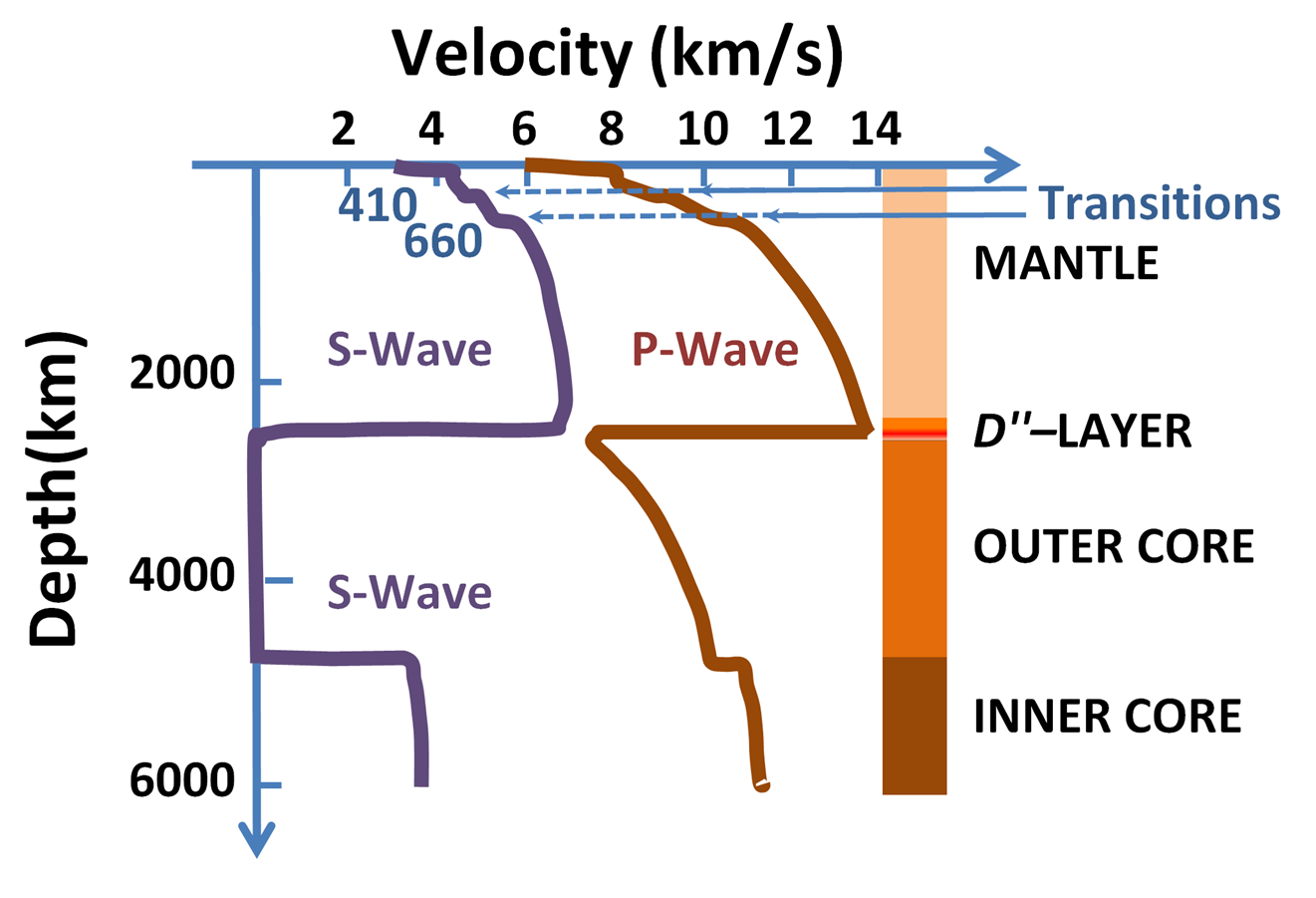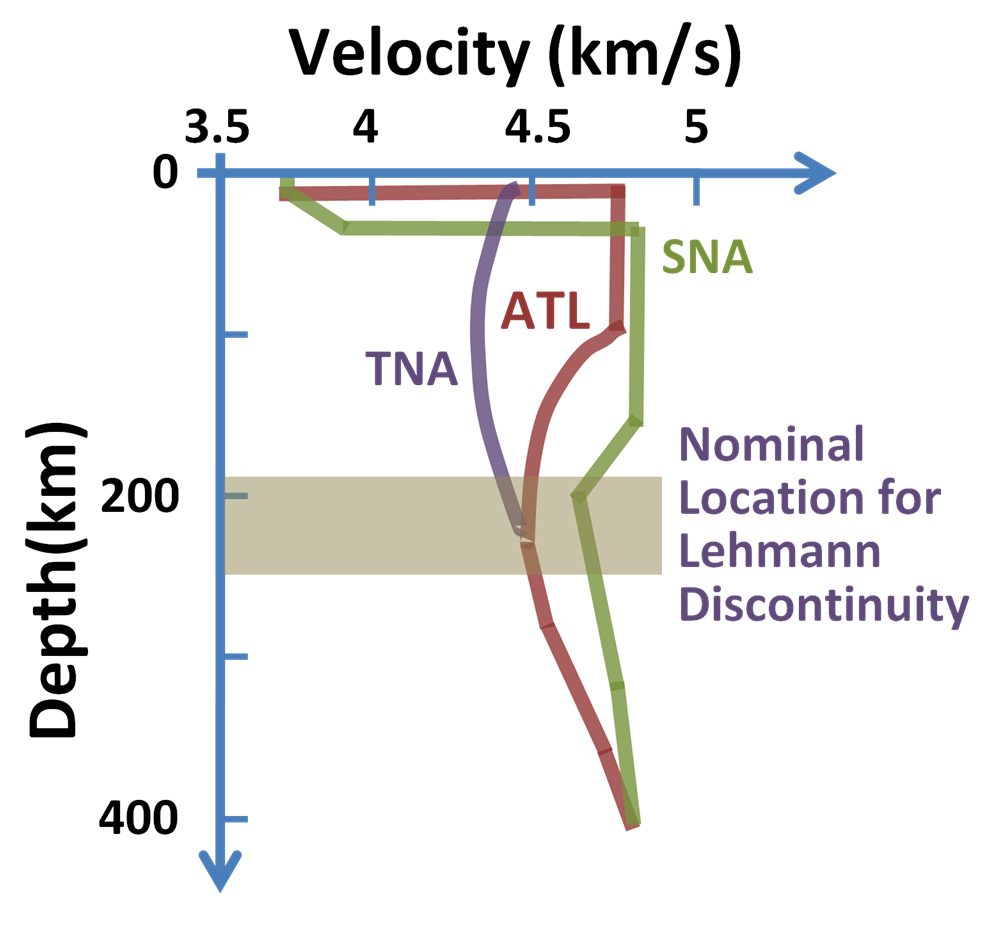low-velocity zone on:
[Wikipedia]
[Google]
[Amazon]
 The low-velocity zone (LVZ) occurs close to the boundary between the lithosphere and the
The low-velocity zone (LVZ) occurs close to the boundary between the lithosphere and the
 The LVZ shows a reduction in velocity of about 3–6% with the effect being more pronounced with
The LVZ shows a reduction in velocity of about 3–6% with the effect being more pronounced with
asthenosphere
The asthenosphere () is the mechanically weak and ductile region of the upper mantle of Earth. It lies below the lithosphere, at a depth between ~ below the surface, and extends as deep as . However, the lower boundary of the asthenosphere is not ...
in the upper mantle
The upper mantle of Earth is a very thick layer of rock inside the planet, which begins just beneath the crust (at about under the oceans and about under the continents) and ends at the top of the lower mantle at . Temperatures range from appro ...
. It is characterized by unusually low seismic shear wave velocity compared to the surrounding depth intervals. This range of depths also corresponds to anomalously high electrical conductivity. It is present between about 80 and 300 km depth. This appears to be universally present for S waves, but may be absent in certain regions for P waves.
A second low-velocity zone (not generally referred to as the LVZ, but as ULVZ) has been detected in a thin ≈50 km layer at the core-mantle boundary.
These LVZs may have important implications for plate tectonics and the origin of the Earth's crust.
The LVZ has been interpreted to indicate the presence of a significant degree of partial melting, and alternatively as a natural consequence of a thermal boundary layer and the effects of pressure and temperature on the elastic wave velocity of mantle components in the solid state. In any event, a very limited amount of melt (about 1%) is needed to produce these effects. Water in this layer can lower the melting point, and may play an important part in its composition.
It is hypothesized that the absence of plate tectonics on the planet Venus is due to the absence of water in its crust and upper mantle. Cooling occurs largely through mantle plumes. See
Identification
The existence of the low-velocity zone was first proposed from the observation of slower than expected seismic wave arrivals from earthquakes in 1959 byBeno Gutenberg
Beno Gutenberg (; June 4, 1889 – January 25, 1960) was a German-American seismologist who made several important contributions to the science. He was a colleague and mentor of Charles Francis Richter at the California Institute of Technolo ...
. He noted that between 1° and 15° from the epicenter the longitudinal arrivals showed an exponential decrease in amplitude after which they showed a sudden large increase. The presence of a low-velocity layer that defocussed the seismic energy, followed by a high-velocity gradient that concentrated it, provided an explanation for these observations.
Characteristics
S-wave
__NOTOC__
In seismology and other areas involving elastic waves, S waves, secondary waves, or shear waves (sometimes called elastic S waves) are a type of elastic wave and are one of the two main types of elastic body waves, so named because th ...
s compared to P-wave
A P wave (primary wave or pressure wave) is one of the two main types of elastic body waves, called seismic waves in seismology. P waves travel faster than other seismic waves and hence are the first signal from an earthquake to arrive at any ...
s. As is evident from the figure, the reduction and depth over which reduction occurs varies with the choice of tectonic province, that is, regions differ in their seismic characteristics. Following the drop, the base of the zone is marked by an increase in velocity, but it has not been possible to decide whether this transition is sharp or gradual. This lower boundary, found beneath the continental lithosphere and oceanic lithosphere away from mid-ocean ridges
A mid-ocean ridge (MOR) is a seafloor mountain system formed by plate tectonics. It typically has a depth of about and rises about above the deepest portion of an ocean basin. This feature is where seafloor spreading takes place along a diver ...
, is sometimes referred to as the Lehmann discontinuity
__NOTOC__
The Lehmann discontinuity is an abrupt increase of ''P''-wave and ''S''-wave velocities at the depth of , discovered by seismologist Inge Lehmann. The thickness is 220 km . It appears beneath continents, but not usually beneath ocean ...
and occurs at about 220±30 km depth. The interval also shows a reduction in Q, the seismic quality factor (representing a relatively high degree of seismic attenuation), and a relatively high electrical conductivity
Electrical resistivity (also called specific electrical resistance or volume resistivity) is a fundamental property of a material that measures how strongly it resists electric current. A low resistivity indicates a material that readily allows ...
.
The LVZ is present at the base of the lithosphere except in areas of thick continental shield where no velocity anomaly is apparent.
Interpretation
The interpretation of these observations is complicated by the effects of seismic anisotropy, which may greatly reduce the actual scale of the velocity anomaly. However, because of the reductions in Q and electricalresistivity
Electrical resistivity (also called specific electrical resistance or volume resistivity) is a fundamental property of a material that measures how strongly it resists electric current. A low resistivity indicates a material that readily allows ...
in the LVZ, it is generally interpreted as a zone in which there is a small degree of partial melting. For this to occur at the depths where the LVZ is observed, small amounts of water and/or carbon dioxide must be present to depress the melting point of the silicate minerals. Only 0.05–0.1 % water would be sufficient to cause the 1% of melting necessary to produce the observed changes in physical properties. The lack of LVZ beneath continental shields is explained by the much lower geothermal gradient, preventing any degree of partial melting.
See also
* Geophysical anomaliesReferences
{{Reflist Tectonics Seismic zones Structure of the Earth